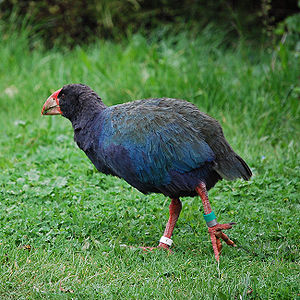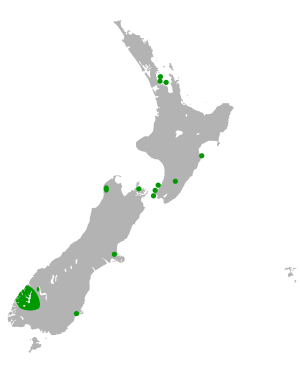Takahē
The takahē or South Island takahē (Porphyrio hochstetteri) is a bird. It lives in South Island, New Zealand. There are two species, and they are commonly called rails. Its family is the Rallidae. It is the largest living rail species in the world. The two species are also known as notornis.
| Takahē | |
|---|---|

| |
| On Tiritiri Matangi Island | |
| Conservation status | |
| Scientific classification | |
| Kingdom: | Animalia |
| Phylum: | Chordata |
| Order: | Gruiformes |
| Family: | Rallidae |
| Genus: | Porphyrio |
| Species: | P. hochstetteri
|
| Binomial name | |
| Porphyrio hochstetteri (A. B. Meyer, 1883)
| |

| |
| Distribution of South Island takahe, including sanctuaries | |
| Synonyms | |
| |
The takahe cannot fly.[3]
Adults are 2.3 – 3.8 kg. They have red legs and a red beak. Their feathers are different shades of blue and green: dark blue on the head and neck, lighter blue on the shoulders. The feathers on the wings and back can be iridescent. Takahē cannot fly, so they were hunted extensively by the Māori.[3]
Takahē live in grassy places. They eat the starchy parts of grassy plants: tussock and sedge plants. In the winter, they go to the forests and look for food there.[3]
Wild takahē can live for 16-18 years, and a little longer in zoos.[3]
Threats
For a long time, people thought this bird was extinct. In 1948, Geoffrey Orbell found some takahē in the Murchison Mountains in Fiordland. Humans started raising the chicks and then letting them go in good places.
Animals that humans brought to New Zealand eat this bird. For example, humans brought stoats to New Zealand, and they eat eggs, chicks, and larger birds. Human beings also change the places where they like to live.[3]
The North Island takahē is extinct.
Takahē Media
The first illustration of the South Island takahē from Gideon and Walter Mantell's notice of the discovery in 1850
Ringed female South Island takahē at Kapiti Island.
South Island takahē released at Maungatautari Restoration Project ecological island, Waikato District, North Island in June 2006.
References
- ↑ BirdLife International (2013). "Porphyrio hochstetteri". IUCN Red List of Threatened Species. IUCN. 2013. Retrieved 26 November 2013.
- ↑ "Porphyrio hochstetteri". nztcs.org.nz. Retrieved 2020-02-16.
- ↑ 3.0 3.1 3.2 3.3 3.4 "Takahē". New Zealand Department of Conservation. Retrieved September 26, 2022.

